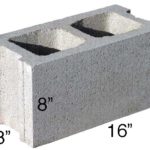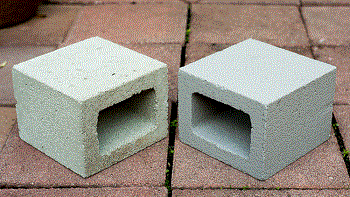Before we even begin touching on the subject of cinder block sealers, let’s figure out first, what are cinder blocks and why they are different.
What are cinder blocks and why are they different
If you never heard the phrase CMU before, you’re probably not in the construction field, and that’s ok. But to better understand how to seal cinder blocks, you need to understand what CMU’s are. So in a nut shell, CMU is a short for Concrete Masonry Unit. It also refers to all concrete blocks, cinder blocks and split face as well as light weight blocks.
So when someone says CMU, now you know what they mean. Usually these type of bricks are used in construction for the foundation walls of the building or house, also for the exterior walls, retaining walls and non load bearing partition walls.
While all CMU may look very similar to you, they are in fact, different in many ways.

When you remove this type of brick from the mold, it will usually hold it’s shape right away. The standard concrete block usually comes in a size of 8 inches by 8 by 16 inches and it weighs around 40 lbs.

Why are they called Cinder Blocks? That’s a great question, it’s dated back to when factories and power plants used to cook ovens in steel mills and produced a ridiculous amounts of cinders, the effect off burning huge amounts of coal.
The more modern version of the cinder block is made from volcanic pumice and not the old days cinder remains. Some contractors still prefer to work with cinder blocks because they are much more light, weighing only around 30 lbs. But you should know these type of blocks are much more delicate to moisture and usually you won’t use them on the out side of the building. Maybe on inner walls or for fencing.
- Fun fact – Some cinder blocks release mercury and other metal contaminates so it’s just another reason why you should want to seal them
How to tell the difference between a cinder block and a regular concrete block?
Cinder blocks will usually have a much more darker color to them and their texture will be very different from that of plain concrete.
There is also the term – Lightweight CMU’s which simply means that they replaced the gravel with shale or clay and toast it in very high temperatures to make the blocks much lighter. They weigh around 24 lbs for a unit.
The Slip-faced block – This type of block has a much rigged or even rough stone like texture on one side instead of the familiar smooth surface.
Haydite blocks – Another expanded shale brick and also very light weight. Please note though that light weight bricks can’t be used in retaining walls or exterior walls because they readily seep water like crazy.
So why do cinder blocks leak anyway?
That’s a great question. After realising the above, we know that cinder blocks are not only lighter, but rather much more hollow than their friend the cement brick. If your home or building is built with foundation walls cinder blocks, you are in much more chance of getting leaks.
After your exterior water proof coating will deteriorates ( and it will ) you are left with a pretty thin and hollow brick to save your interior from the water or cold. It’s only a matter of time.
So cinder blocks are penetrable, unlike their concrete blocks friends. Usually you will have around 1 or 1 and 1/4 thin wall protecting your structure. That’s not a lot. When the base will be filled with water during harsh weather conditions, it will moist and go through the cinder blocks slowly but surly.
If you want to get technical, here is a term to see:
Cinder blocks are classified as permeable to water = >10 perms.
Standard concrete block is semi-permeable = ~5 perms.
A great newly concrete poured wall with 8-10 inches thick is considered impermeable
How to seal cinder blocks walls
The best and easiest way to make sure your cinder blocks will not leak is to take preventive actions before you need it. Cinder block sealers is our main topic in this article but we wanted to give you a much more wider information on the subject.
So, taking a preventable approach is much more cheaper and easier to extend the life of your cinder blocks. If you think you can NOT seal your cinder blocks, you are mistaken. You can use RadonSeal if you like, or you can just call your local masonry sealing expert to help you get it done in no time.
The thing is, if you don’t act fast, your blocks may become unsealable because the water and moist will widen the pores making it much more difficult to seal in the future and causing you to potentially needing to re-do the entire wall.
You can tell the damage to the brick is serious by looking at the interior side of it and trying to see if it’s in a brown, reddish color. This situation will make it difficult to seal with with waterproofing paints or Parge coating. Don’t get to this situation, take care of your wall before it’s too late.
If you still want to do it yourself, here’s how to seal your cinder brick wall
You can use a product like RadonSeal Plus Penetrating Concrete Sealer to help waterproof and preserve the overall look of your wall. It will help permanently block the elements like moisture and water. It’s fairly easy to apply if you know your way around the house. Here are easy steps to do it:
1. Remove paint to the bare brick – This is the first and obvious step. Your blocks must be bare and clean to work with. Remove any paint how ever you know how, or again use the service of a professional contractor, it’s up to you, as long as it gets the job done.
2. Let the Cinder blocks wall dry completely – You can’t apply RadonSeal or any other sealing product until the blocks are dry. If you see wet spots, you need to let them dry out first by putting fans in the room and letting them do their thing.
3. Apply the product – You should apply four, back-to-back applications of the product ( make sure to read the instructions carefully before starting ). You can use a regular hand pump or garden sprayer.
If you think this will be too much to handle, or you just don’t have the time, it will best to call your local brick and masonry contractor to help you deal with the situation and get it done on the best possible side.
*image sources: inchcalcuator, quora, civilengineersforum



